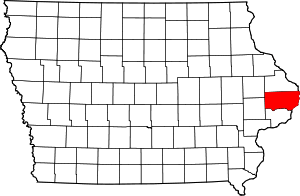Howes Building
|
Howes Building | |
|
Howes Building | |
  | |
| Location |
419-425 Second St. S Clinton, Iowa |
|---|---|
| Coordinates | 41°50′30″N 90°11′15″W / 41.84167°N 90.18750°WCoordinates: 41°50′30″N 90°11′15″W / 41.84167°N 90.18750°W |
| Area | less than one acre |
| Built | 1900 |
| Architectural style | Classical Revival |
| NRHP Reference # | 04001351[1] |
| Added to NRHP | December 15, 2004 |



The Howes Building is a building in Clinton, Iowa. It was constructed by Edward Madison Howes (March 11, 1855 - February 9, 1936). His architect was Josiah Rice for the first three stories, finished in 1900 and John Morrell for the fourth story, finished in 1905.
Architecture
Exterior-South (Fifth Avenue) and West (Second Street South) Facade- Front of Building The site of the Howes Building on the corner of Fifth Avenue and Second Street South was a very important location for commercial and retail business in Clinton, Iowa at the turn of the 20th century. Therefore, south and west facades of the Howes building were constructed with uniformly ornate and impressive design features. The wrap around design of the building unifies the south and west facade as the “front” of the building. Similarly, the building’s grand entrance was placed at an angle on the corner to emphasize the importance of both the south and west facade.
The original grand entrance to the building is accentuated by the chamfered corner of the building’s southwest façade. The effect of the chamfered corner is enhanced by careful placement of three window bays. The three rows of windows outline the chamfered corner with one bay in the center nestled between two remaining window bays. Two grand Ionic order pilasters made of red brick and topped with terra cotta capitals with decorative volutes separate and enrich the corner window bays. On the chamfered corner, a name stone reading “Howes” sits between the windows on the third and fourth level and a date stone reading “A.D. 1900” sits atop the fourth story window, just under the roof cornice.
The street level of the Howes Building hosts the most dramatic exterior alterations. According to the building’s previous owner (grandson of Edward M. Howes), the street level façade was first altered in 1914. Over the years, the street level of the building has undergone several alterations. In fact, much of the street level of the building has been covered with stucco and a rose quartz textured stone or wood. However, some of the original pilasters between display windows, columns and brick detail are thought to remain beneath a protective layer of plywood to which the stucco was applied.
The original chamfered corner entrance was set back within the building and was flanked by two large Doric columns. This grand entrance has been closed off with windows and is no longer an entrance to the building, but still possesses the original Doric order columns from the grand entrance. In addition, the original doorways which flank the building’s borders to the west (Second Street entrance) and south (Fifth Avenue entrance) remain intact. The Smaller, modern replacement windows with green awnings have replaced the original large transomed windows.
Upper stories of the Howes Building façade remain predominantly unaltered. The building’s second, third and fourth levels retain historical integrity with original red brick and terra cotta ornamentation. The windows are situated in symmetrical pairs divided and accentuated by ornamental brick pilasters. The Ionic pilasters feature decorative capitals with protruding volutes and are located between the third and fourth stories, representative of the building’s original 1900 roof line.
Exterior-South (Fifth Avenue) and West (Second Street South) Facade- Front of Building
The fourth story was added to the building in 1905 and represents a slight aesthetic departure from the building’s original Classic Revival symmetry. Windows on the 4th story were designed smaller than those on the second and third stories but are positioned in keeping with the original window bays. There are two smaller windows on the fourth level to each large window of the second and third stories. The roof line on the 1905 fourth story addition has classical style moldings on an ornamental cornice which projects from the top of the building.
The Howes Building has been listed in the National Register of Historic Places.
Notes
- ↑ National Park Service (2010-07-09). "National Register Information System". National Register of Historic Places. National Park Service.
References
- The Clinton Daily Herald September 16, 1899
- The Clinton Daily Herald Monday August 27, 1900 p. 5
- The Clinton Daily Herald Saturday September 1, 1900 p. 3
- The Clinton Daily Herald Tuesday September 11, 1900 p. 3
- The Clinton Daily Herald Saturday September 15, 1900 p. 5
- The Clinton Herald Monday June 15, 1931
